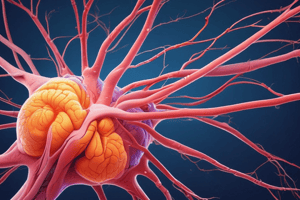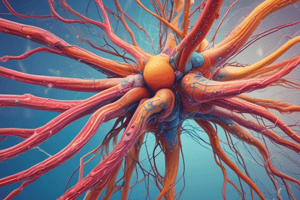Podcast
Questions and Answers
Which area of the brain is involved in modifying autonomic functions through emotional responses?
Which area of the brain is involved in modifying autonomic functions through emotional responses?
What physiological change may occur during psychological disturbances?
What physiological change may occur during psychological disturbances?
Which reflex is activated by thinking or seeing food, leading to increased secretion of digestive fluids?
Which reflex is activated by thinking or seeing food, leading to increased secretion of digestive fluids?
What is the primary role of the medulla oblongata in autonomic control?
What is the primary role of the medulla oblongata in autonomic control?
Signup and view all the answers
Which structure is considered the principal higher center for the autonomic nervous system?
Which structure is considered the principal higher center for the autonomic nervous system?
Signup and view all the answers
Stimulation of which nuclei in the hypothalamus leads to increased sympathetic functions?
Stimulation of which nuclei in the hypothalamus leads to increased sympathetic functions?
Signup and view all the answers
Which autonomic function is associated with the anterior nuclei of the hypothalamus?
Which autonomic function is associated with the anterior nuclei of the hypothalamus?
Signup and view all the answers
Which of the following is NOT a function of the hypothalamus?
Which of the following is NOT a function of the hypothalamus?
Signup and view all the answers
What is the role of spinal vasomotor centers?
What is the role of spinal vasomotor centers?
Signup and view all the answers
Which autonomic function does NOT derive from the hypothalamus?
Which autonomic function does NOT derive from the hypothalamus?
Signup and view all the answers
What type of reflex is involved when increased secretion of saliva and gastric juice occurs as a response to thoughts or sights of food?
What type of reflex is involved when increased secretion of saliva and gastric juice occurs as a response to thoughts or sights of food?
Signup and view all the answers
Which of the following statements best describes the voluntary control over autonomic functions?
Which of the following statements best describes the voluntary control over autonomic functions?
Signup and view all the answers
During physical exercise, which change occurs in the body due to higher control of autonomic functions?
During physical exercise, which change occurs in the body due to higher control of autonomic functions?
Signup and view all the answers
Which area of the brain does NOT play a direct role in modifying autonomic functions?
Which area of the brain does NOT play a direct role in modifying autonomic functions?
Signup and view all the answers
Which autonomic function is regulated by the pons?
Which autonomic function is regulated by the pons?
Signup and view all the answers
What effect does stimulation of the anterior nuclei of the hypothalamus have?
What effect does stimulation of the anterior nuclei of the hypothalamus have?
Signup and view all the answers
What vital function is NOT regulated by the medulla oblongata?
What vital function is NOT regulated by the medulla oblongata?
Signup and view all the answers
In what way does the hypothalamus contribute to the internal environment?
In what way does the hypothalamus contribute to the internal environment?
Signup and view all the answers
Which autonomic responses are enhanced by the posterior nuclei of the hypothalamus?
Which autonomic responses are enhanced by the posterior nuclei of the hypothalamus?
Signup and view all the answers
Which structure is responsible for micturition control alongside the pons?
Which structure is responsible for micturition control alongside the pons?
Signup and view all the answers
What function is associated with the spinal vasomotor centers?
What function is associated with the spinal vasomotor centers?
Signup and view all the answers
Which of the following activities is primarily reflexive and may involve the sacral spinal cord?
Which of the following activities is primarily reflexive and may involve the sacral spinal cord?
Signup and view all the answers
Study Notes
Autonomic nervous system integration within CNS
- Autonomic functions are integrated at various levels within the CNS.
- Simple autonomic functions like micturition, defecation and erection are reflexively integrated in the sacral segments of the spinal cord.
Spinal Vasomotor Centers ( LHCs)
- Maintain vascular tone.
- Integrate some cutaneous vascular reactions.
Medulla Oblongata
- Contains vital centers that control cardiovascular and respiratory functions, gastric secretion and vomiting.
Pons
- Regulates respiration and salivary secretions.
- Controls micturition and ocular reflexes like pupillary light reflex and accommodation reflex.
Midbrain
- Controls the pupillary light reflex and accommodation reflex.
Hypothalamus
- Principal higher center for autonomic nervous system.
- Head ganglion of autonomic nervous system.
- Regulates food intake, adrenaline secretion, body temperature, and body water.
- Plays a pivotal role in maintaining internal environment stability.
- Affects the activity of almost all the brain stem autonomic centers.
- Stimulation of the anterior nuclei of the hypothalamus leads to increased parasympathetic function.
- Stimulation of the posterior nuclei of the hypothalamus leads to increased sympathetic function.
Cerebral Cortex
- Certain areas of the cerebral cortex can modify autonomic functions directly or through reticular formation.
- Cerebral cortex influences cardiovascular and gastrointestinal changes during psychological disturbances.
- Increased blood flow to skeletal muscles during exercise.
- Increased saliva and gastric juice secretion on seeing or thinking about food (conditioned reflex).
- Voluntary control of micturition and defecation.
- Some conscious control of heart rate and respiratory rate by yoga players.
Limbic System
- Group of tracts and nuclei that form a ring (limbus) around the brain stem.
- Limbic system plus hypothalamus are involved in emotions like fear, anger, sadness, hunger and memory.
- Limbic stimulation leads to autonomic effects, particularly changes in arterial blood pressure and respiration in response to emotional reactions.
Autonomic Nervous System Integration Within the CNS
- Autonomic functions are integrated in the central nervous system (CNS) at various levels.
- Simple autonomic reflexes, like micturition, defecation, and erection, are primarily controlled by sacral segments of the spinal cord.
- Spinal vasomotor centers (LHCs) maintain vascular tone and integrate cutaneous vascular reactions.
Vital Centers of Autonomic Control
- Medulla Oblongata: Controls vital functions such as cardiovascular and respiratory functions, gastric secretion, and vomiting.
- Pons: Regulates respiration, salivary secretion, micturition, and ocular reflexes like pupillary light reflex and accommodation reflex.
- Midbrain: Plays a role in ocular reflexes (pupillary light reflex and accommodation reflex).
Hypothalamus: The Head Ganglion of the Autonomic Nervous System
- The hypothalamus acts as the principal higher center for the autonomic nervous system.
- It regulates various functions, including:
- Food intake.
- Adrenaline secretion.
- Body temperature.
- Body water.
- It plays a crucial role in maintaining the internal environment.
- Hypothalamus can influence various brainstem autonomic centers.
- Stimulation of anterior nuclei results in increased parasympathetic functions:
- Decreased heart rate and arterial blood pressure.
- Pupillary constriction.
- Increased gastrointestinal motility and micturition.
- Stimulation of posterior nuclei results in increased sympathetic functions:
- Increased heart rate and arterial blood pressure.
- Pupillary dilatation.
- Erection of hair and adrenaline secretion.
- Stimulation of anterior nuclei results in increased parasympathetic functions:
Cerebral Cortex and Autonomic Control
- Certain areas of the cerebral cortex can directly or indirectly modify autonomic functions through the reticular formation.
- Examples of cortical influence include:
- Cardiovascular and gastrointestinal changes during psychological disturbances.
- Increased blood flow in skeletal muscles during exercise.
- Increased saliva and gastric juice secretion upon thinking or seeing food (conditioned reflex).
- Voluntary control of micturition or defecation.
- Conscious control of heart rate and respiratory rate by yoga practitioners.
Limbic System and Autonomic Control
- The limbic system, a group of tracts and nuclei surrounding the brainstem, is involved with emotions.
- The limbic system, along with the hypothalamus, is involved with emotions like fear, anger, sadness, hunger, and memory.
- Stimulation of the limbic system results in autonomic effects, particularly changes in arterial blood pressure and respiration in response to emotional reactions.
Studying That Suits You
Use AI to generate personalized quizzes and flashcards to suit your learning preferences.




